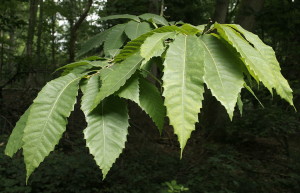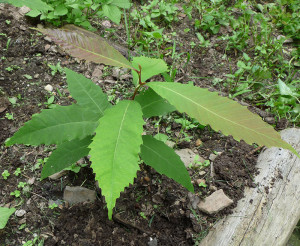Last February I wrote a very hopeful essay about the possible resurrection of the American chestnut tree. American chestnuts were once one of the most abundant trees in the eastern United States making up thirty to fifty percent of all of the trees in our forests. They were trees of massive girth that had trunks ten or twelve feet in diameter and thick, extending, shading branches that spread out over remarkably large areas (Photo of virgin American chestnut trees used with permission from the Forest History Society).
The American chestnut (Castanea dentata) also produced large numbers of extremely palatable nuts that were eaten not only by squirrels, birds, deer, and bears but also humans. The American chestnut produced these nuts in abundance every year (unlike oak trees, say, that make their acorns over multi-year, boom and bust cycles). Many animals relied on the yearly production of chestnuts to sustain their populations.
In 1904, though, the American chestnuts lining the roads and walkways of the Bronx Zoo began to sicken. Their leaves withered and great lesions appeared in their bark. The trees then died one by one. They were the first recorded casualties of Chestnut Blight epidemic that swept through the eastern United States. There is evidence that the fungus responsible for this disease (Cryphonectria parasitica) had been present in the southern U.S. since the 1820’s, but the death of the chestnuts in New York set off alarms that reverberated through the country. By 1950, the American chestnut was for all intents and purposes “gone.” It was no longer a reliable source of nuts or timber. It was no longer a tree of size and majesty.
Last February’s essay was about two researchers at the State University of New York College of Environmental science and Forestry (SUNY-ESF) (one of Deborah’s and my alma maters) who had developed a transgenic American chestnut that was resistant to the chestnut blight fungus. These researchers (Bill Powell and Chuck Maynard) recognized that the fungus’ production of oxalic acid was essential to its infective physiology. So they took a gene from wheat that codes for an enzyme that breaks down oxalic acid, incorporated it into the chestnut’s genome, and came up with a blight resistant American chestnut tree. They are waiting for final federal review and approval so that they can begin planting these trees back into the forests of the eastern United States.
The final phase of this SUNY-ESF project is to raise and plant ten thousand of these blight resistant, transgenic American chestnut trees. Last fall, to raise funds for this effort, the Development Office of SUNY-ESF set up a crowd funding campaign called the “Ten Thousand Chestnut Challenge.” They sent emails to SUNY-ESF alumnae and to past donors to the college hoping to raise the fifty thousand dollars needed to cover the costs of this tree production program. In the four brief weeks of the campaign, they raised over one hundred and four thousand dollars!
A benefit of becoming a contributor to this chestnut tree crowd funding challenge was that you received a small bag of American chestnut tree seeds as a token of thanks. These seeds are not for the transgenic, blight resistant American chestnut, but instead are from a genetically diverse array of wild American chestnut trees. The trees grown from these seeds will serve as “Mother” trees that will be crossed with the transgenic chestnuts to greatly expand their genetic base! My zip-lock bag of chestnut seeds spent the winter in the salad crisper drawer of my refrigerator and germinated beautifully this spring. I now have them out growing in a corner of my garden (photo to the left) from which in a year or two I will transplant them out into my woodlot or field edge.
I have a cluster of American chestnut trees already growing out in the back, northwest edge of my property. These trees are about 40 years old and produce huge numbers of nuts each fall. I have to fight the squirrels to get any of these nuts at all! Looking closely at the leaves of the SUNY-ESF trees and my established trees, I now think that my chestnuts are Chinese/American hybrids that were bred to resist the blight. I will plant my new trees some distance away from the old.
If you want to read more about this fantastic research and rehabilitation effort, check out www.esf.edu/chestnut . There are two associations that are working hard to develop a blight resistant American chestnut tree: The American Chestnut Foundation (which includes Penn State) and The American Chestnut Research and Restoration Center (which is based at SUNY-ESF). Through incredible time and effort the scientists of these groups are now very close to developing American chestnut tree strains that are not affected by the blight. The thought that we might soon be able to re-establish these magnificent (and ecologically significant) trees throughout our eastern forests is one of the most hopeful and exhilarating pieces of environmental news that I have heard in decades.
A few years ago Deborah and I made an ecology sign for the section of the Great Allegheny Passage trail where it passes over the Chestnut Ridge in southwestern Pennsylvania. The theme of the sign was “where did all the chestnuts go?” It would be incredible if the Chestnut Ridge could one day live up to its historical name! Let’s hope that our grandchildren will someday see it covered once again with American chestnut trees! I would be very happy to edit and update that sign!




I have heard Bill speak in the past about the new strains and am interested in planting some seeds when they are available again. I have about twelve acres of land outside of Auburn, NY. I am an SU alum, so am pleased that these studies are taking place at SUNY -ESF.